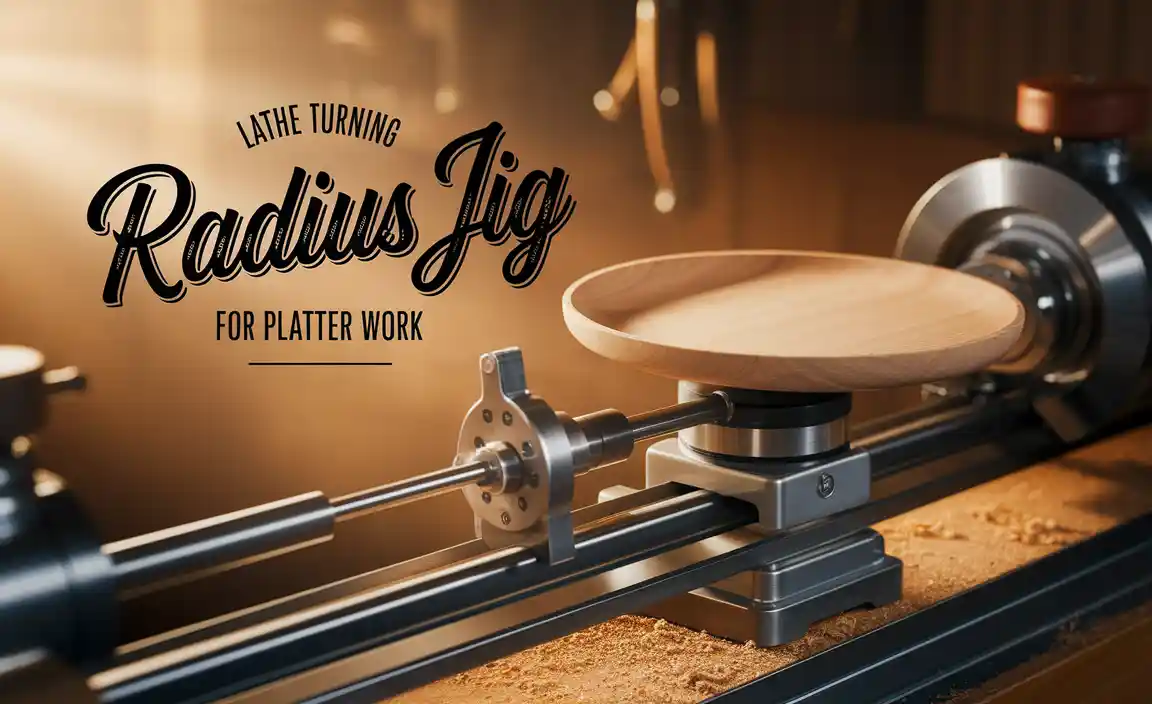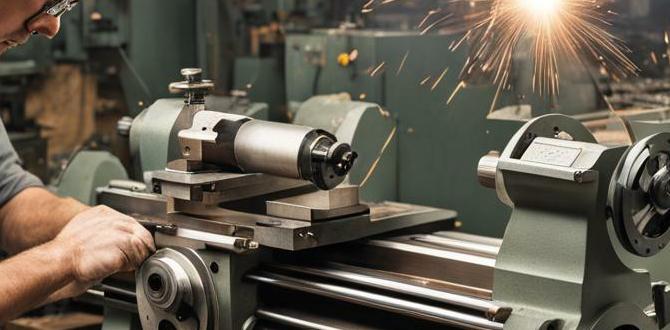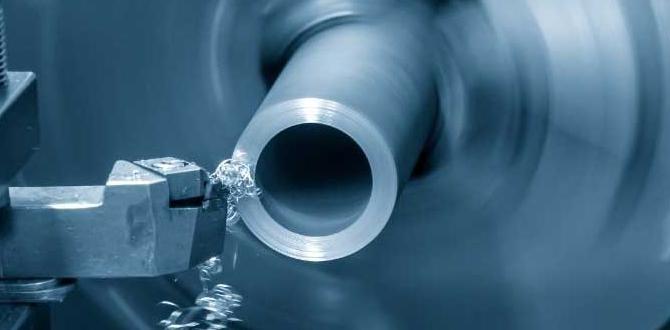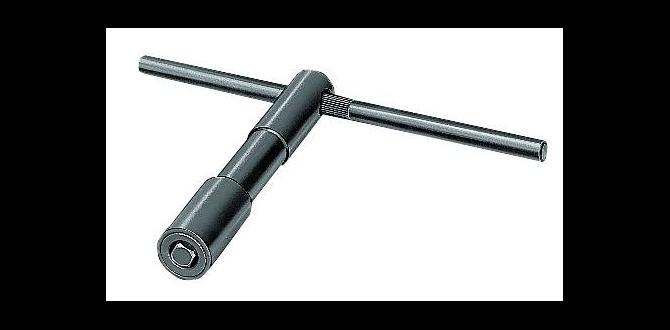Quick Summary
Successfully milling copper with a carbide end mill is achievable! Using the right end mill, like a 3/16 inch 8mm shank long reach for copper, advanced geometry, and dialing in your speeds and feeds minimizes deflection and chatter, ensuring clean cuts and a smooth finish. This guide breaks down the process for beginner success.
Carbide End Mill: Proven Copper Milling Success for Beginners
Milling copper can be a sticky situation, literally! Many hobbyists and beginners find that copper has a tendency to gum up tools, leading to rough surfaces, tool breakage, and a lot of frustration. It’s a common challenge when you’re transitioning into working with softer, more ductile metals on your milling machine.
But don’t let that discourage you! With the right approach, milling copper can be surprisingly smooth and rewarding. The key is understanding how to use the right tools and techniques to keep things clean and efficient. We’ll walk you through exactly how to achieve great results with your carbide end mills.
Ready to conquer copper? Let’s dive into the simple steps that will lead to your most successful copper milling projects yet!
Why Copper Can Be Tricky to Mill
Copper is a beautiful and useful metal, but it presents some unique challenges when it comes to machining. Unlike harder metals, copper is quite soft and ductile. This means:
- Stickiness: As you cut, copper wants to stick to the cutting edges of your end mill. This “built-up edge” (BUE) can effectively change the geometry of your tool, making it cut poorly and generate more heat.
- Gummy Chips: Instead of breaking into small, manageable pieces, copper tends to meld together to form long, stringy chips. These chips can clog flutes, leading to poor chip evacuation and even tool breakage.
- Requires Sharp Tools: Because of its tendency to stick, you need exceptionally sharp tools. Dull edges will grab and tear the material, exacerbating the BUE problem.
These issues often lead to poor surface finishes, excessive tool wear, and frustrating scrap parts for beginners. The good news is that by selecting the right carbide end mill and optimizing your machining parameters, these problems are easily overcome.
Choosing the Right Carbide End Mill for Copper
Not all carbide end mills are created equal, especially when it comes to milling softer metals like copper. For successful copper milling, you’ll want an end mill specifically designed for the job. Look for these key features:
1. Material: Solid Carbide is King
Solid carbide end mills offer superior hardness and heat resistance compared to high-speed steel (HSS). This is crucial for copper because it helps prevent the material from welding onto the cutting edge. While carbide is brittle, for most beginner applications with proper setup, it’s the best choice.
The National Tooling & Machining Association (NTMA) highlights the importance of correctly selecting tooling materials for specific applications. For softer metals like copper, carbide’s heat resistance and hardness are significant advantages, even with its brittleness.
2. Geometry Matters: The Key to Smooth Cuts
The shape and angles of the end mill’s cutting edges are critical for milling copper. Here’s what to look for:
- High Helix Angle: A high helix angle (typically 30-45 degrees, sometimes even higher) helps to “shear” the material cleanly, reducing friction and the tendency for copper to stick. It also aids in pushing chips up and out of the flute.
- Polished Flutes: End mills with highly polished or mirror-finished flutes are essential. This smooth surface finish prevents copper chips from adhering to the tool, dramatically improving chip evacuation and tool life.
- Fewer Flutes: For softer, gummy materials like copper or aluminum, end mills with fewer flutes (2 or 3) are generally preferred. More flutes mean less space for chips to escape, which can lead to packing and clogging. Two flute end mills are often ideal for copper.
- Sharp Cutting Edges: Look for end mills advertised as having very sharp, refined cutting edges.
3. Specific End Mill Types to Consider
When searching for the perfect tool, you’ll often find them described as:
- “Copper Mill” or “Aluminum Mill”: These are often specifically designed with the geometry mentioned above for soft, gummy metals.
- “High-Performance” or “Finishing” End Mills: These often have polished flutes and sharp edges suitable for copper.
4. Size and Reach: A Critical Combination
For your specific keyword, “carbide end mill 3/16 inch 8mm shank long reach,” this combination is excellent for tackling copper, especially if you want to minimize deflection.
- 3/16 inch Diameter: This is a common and versatile size for many projects.
- 8mm Shank: This is very close to a 5/16 inch shank (0.3125″) and offers good rigidity. A larger shank generally means a more rigid tool.
- Long Reach: This is where it gets interesting. A “long reach” end mill has a longer cutting flute length relative to its diameter. While useful for reaching into deep pockets, it also presents a higher risk of deflection (the tool bending under cutting forces).
Minimizing Deflection with Long Reach Tools: To combat deflection with a long reach end mill, you must reduce the cutting forces. This means using lighter cuts (smaller depth of cut and/or width of cut), ensuring excellent rigidity in your setup (spindle, collet, workpiece), and using appropriate cutting speeds and feed rates. Often, a standard length end mill of the same diameter will deflect less. However, if the geometry is correct (polished, high helix, 2-flute), a long reach can still work well if managed properly with lighter cutting parameters.
Recommended Carbide End Mill Specifications for Copper
Here’s a table summarizing ideal features for a carbide end mill used to mill copper:
| Feature | Recommendation for Copper | Why It Matters |
|---|---|---|
| Material | Solid Carbide | Resists heat buildup and wear, preventing copper from welding to the edge. |
| Flute Count | 2 or 3 Flutes | Allows for better chip evacuation, reducing clogging in gummy material. |
| Helix Angle | High Helix (30-45 degrees or more) | Provides a shearing action, reducing cutting forces and chip adhesion. |
| Flute Finish | Polished or Mirror Finish | Minimizes friction and prevents copper from sticking to the flute. |
| Edge Prep | Sharp, refined cutting edges | Essential for clean cuts and reducing the tendency to “drag” or tear the material. |
| Coatings | Uncoated or specific coatings for non-ferrous metals (e.g., Zirconium) | Most often, uncoated, polished end mills are preferred for their inherent non-stick properties on copper. Some specialized coatings can also work. |
Setting Up Your Milling Operation for Copper
Once you have the right end mill, proper setup is your next critical step. This ensures stability, safety, and the best possible cutting action.
1. Secure Workholding is Non-Negotiable
Copper is soft, which means it can easily be distorted or moved if not held down securely. Use robust workholding methods suited for your milling machine:
- Machine Vise: A good quality milling vise with soft jaws (brass or aluminum) is often sufficient. Ensure the vise is clean and the jaws are parallel to the table.
- Clamps: If using clamps, ensure they are positioned to avoid interfering with the end mill’s path. Never clamp over an area you intend to machine.
- Fixtures: For repetitive or complex parts, a custom fixture can provide the best holding force and repeatability.
Make sure the workpiece is held as close to the machining surface as possible to minimize leverage for vibration and deflection.
2. Ensure Rigidity in Your Setup
Vibration (chatter) is the enemy of good finishes and tool life. Check for:
- Collet Runout: A clean, high-quality collet is essential. Ensure your end mill is seated properly. Too much runout will cause erratic cutting. Check out resources on collet maintenance from organizations like ISG-Tec (a tooling supplier) for best practices.
- Spindle Quality: A well-maintained spindle with minimal play is important.
- Machine Stability: Ensure your milling machine is on a stable surface and is properly leveled.
3. Chip Evacuation Strategy
As we’ve emphasized, keeping those gummy copper chips moving is paramount. A good chip evacuation strategy involves:
- Coolant/Lubrication: Using a suitable coolant or lubricant is highly recommended. This cools the cutting edge, lubricates the cut, and helps wash chips away. Flood coolant is ideal. If not available, a mist coolant system or even a simple paste wax or cutting fluid applied manually can help.
- Air Blast: A directed stream of compressed air can help blow chips out of the flute and off the workpiece, especially in dry machining.
- Peck Drilling (for deep holes): If drilling or plunging, peck with frequent retracts to clear chips from the hole.
Optimizing Speeds and Feeds for Copper Milling
This is where many beginners get stuck. Incorrect speeds and feeds are a primary cause of tool damage and poor finishes when milling copper. The goal is to cut cleanly without overloading the tool or letting the copper build up.
Understanding Surface Speed (SFM) and Feed Per Tooth (IPT)
These are the two fundamental parameters. There are many calculators and charts available, but here are some general guidelines for carbide end mills in copper:
- Surface Speed (SFM): Start relatively high for copper with polished, high-helix tools. A good starting point for solid carbide in copper might be in the range of 300-600 SFM (Surface Feet per Minute).
- Feed Per Tooth (IPT): This controls how much material each cutting edge removes per revolution. For a smaller diameter end mill (like 3/16″), the IPT will be quite small. A starting point might be 0.0005″ to 0.0015″ (0.012mm to 0.038mm) per tooth.
Calculating RPM and Feed Rate
You need to convert SFM into RPM (Revolutions Per Minute) for your spindle, and then use IPT to calculate your table feed rate.
Spindle RPM Calculation:
RPM = (SFM × 12) / (π × Diameter)
Where:
- SFM = Surface Feet per Minute
- 12 = inches per foot
- π (pi) = 3.14159
- Diameter = End mill diameter in inches
Table Feed Rate Calculation:
Feed Rate (IPM) = RPM × Number of Flutes × IPT
Where:
- IPM = Inches Per Minute
- IPT = Inches Per Tooth
Example Calculation (3/16 inch end mill)
Let’s use our 3/16 inch (0.1875″) diameter end mill, aiming for 400 SFM and an IPT of 0.001″ per tooth, with a 2-flute end mill.
RPM Calculation:
RPM = (400 SFM × 12) / (3.14159 × 0.1875″)
RPM ≈ (4800) / (0.589)
RPM ≈ 8150 RPM
Feed Rate Calculation:
Feed Rate (IPM) = 8150 RPM × 2 Flutes × 0.001″ IPT
Feed Rate (IPM) ≈ 16.3 IPM
Important Considerations:
- These are starting points! Always listen to the cut. If you hear chattering or see excessive buildup, adjust.
- Reduce Depth of Cut (DOC) and Width of Cut (WOC): To minimize deflection and cutting forces, use lighter cuts. For a 3/16″ end mill, a DOC of 0.060″ to 0.120″ and a WOC of 0.030″ to 0.090″ (15-50% of diameter) are often good starting points. You can often take multiple lighter passes.
- Material Variation: Pure copper is softer than brass or bronze alloys. Adjustments may be needed based on the specific copper alloy.
Using a Cutting Speed Calculator
Instead of manual calculations, using an online cutting speed calculator can save time and reduce errors. Many tooling manufacturers provide these on their websites. For example, ANCA provides comprehensive machining resources and calculators relevant to tool design and application, which can inform your setup.
Achieving a Good Surface Finish
A smooth, clean surface finish is often the goal. Here’s how to get there:
- Final Finishing Pass: Always dedicate your last pass to finishing. This pass should be lighter in depth of cut (e.g., 0.005″ – 0.010″) and potentially a slightly higher feed rate if the machine can handle it smoothly.
- Tool Sharpness: A sharp, unworn tool is paramount for a good finish. If your tool has been cutting for a while, it might need replacing.
- Coolant/Lubrication: A good flood of coolant or lubricant will carry away fine chips and help prevent micro-adhesion.
- Avoid Tool Drag: Ensure the tool isn’t “rubbing” or dragging material. This is often a sign of dullness, incorrect feed rate, or inadequate chip evacuation.
Step-by-Step Guide: Milling Copper with Your Carbide End Mill
Let’s put it all together into a clear, actionable plan. Remember, safety first!
Step 1: Prepare Your Machine and Workpiece
- Ensure your milling machine is clean, lubricated, and stable.
- Select and install your appropriate carbide end mill (e.g., 3/16 inch, 8mm shank, polished flutes, high helix). Ensure it’s firmly seated in a clean R8 or collet.
- Secure your copper workpiece firmly using appropriate workholding. Ensure it’s flat and rigid.
- Set up coolant or lubrication if using.
Step 2: Establish Your Speeds and Feeds
Use the formulas or a calculator to determine your starting RPM and Feed Rate based on your end mill’s diameter, SFM, and IPT. Aim for aggressive SFM and conservative IPT for copper with the right geometry.
- Example: 3/16″ 2-flute end mill, 400 SFM, 0.001″ IPT → ~8150 RPM, ~16 IPM table feed.
Step 3: Set Your Cutting Depths
Determine the total depth of cut required for your part. Divide this into multiple passes. For roughing, you might use a DOC of 0.060″ – 0.100″. For finishing, use a much lighter DOC, around 0.005″ – 0.010″.
Step 4: Engage the Material Safely
When starting a new program or operation:
- Dry Run: If using a CNC, perform a dry run with the spindle off to check tool clearance and axis movements.
- Air Cut: Perform an “air cut” with the spindle on but the Z-axis set high enough to clear the workpiece. Watch and listen to ensure everything is smooth.
- First Plunge/Cut: Lower the Z-axis to the correct depth of cut. Engage the feed rate slowly. Listen for any unusual noises (chattering, rubbing) and watch for chip buildup.
Step 5: Make Your Roughing Passes
- Execute your roughing passes at the determined speeds, feeds, and depths of cut.








